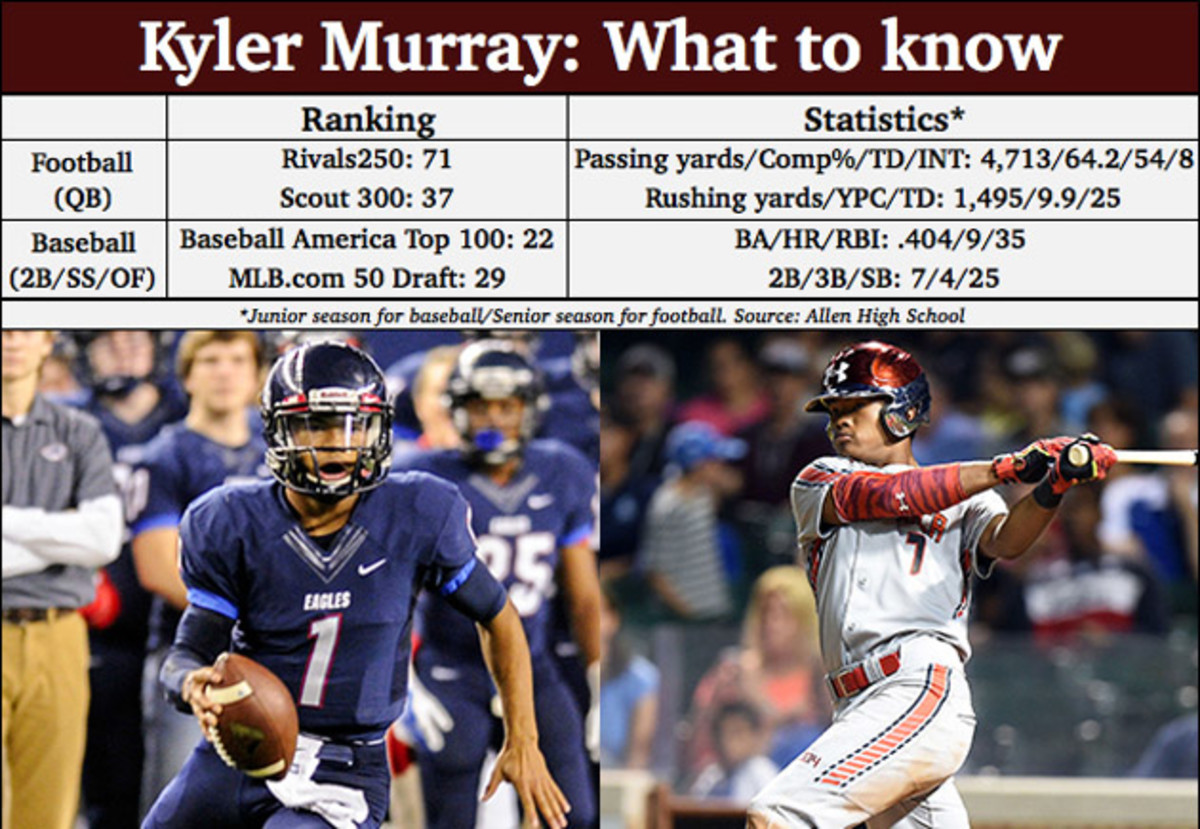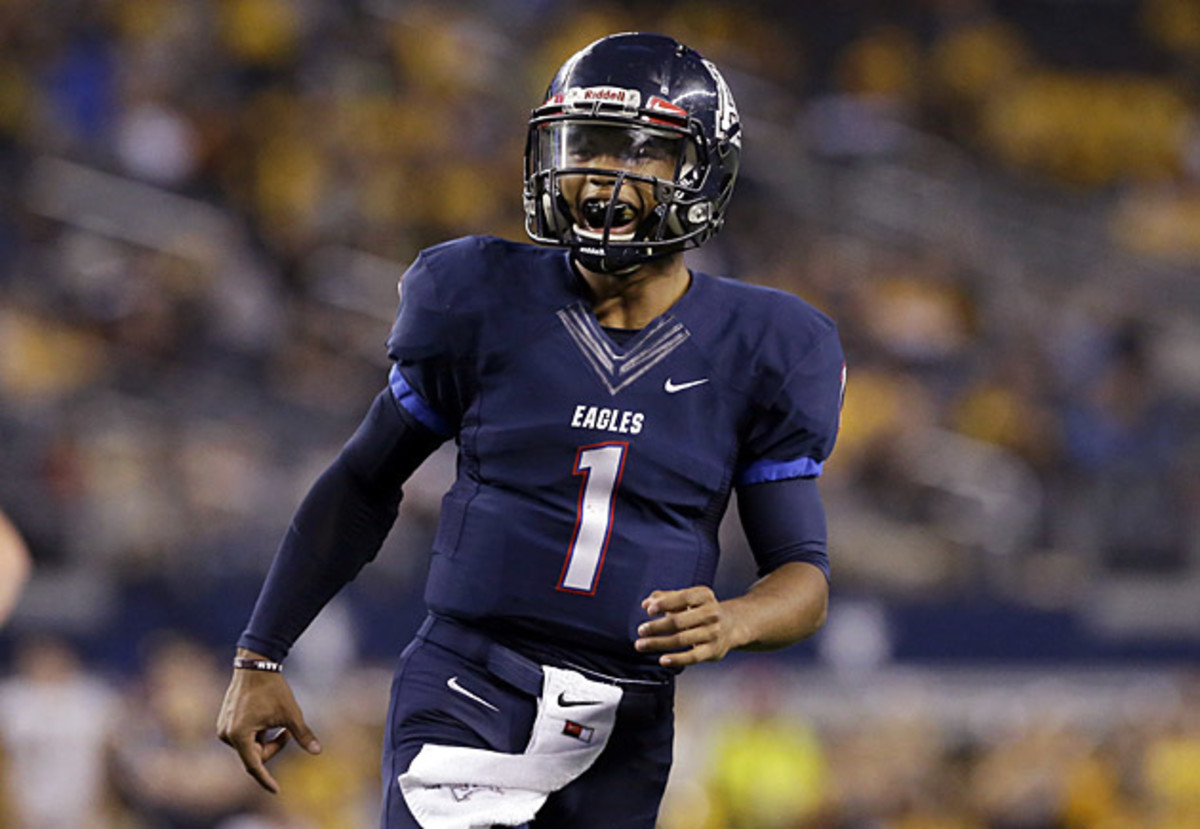Dual-sport dilemma: Could star QB Kyler Murray pursue an MLB career?

Kyler Murray, one of the most sought-after quarterbacks in the 2015 recruiting class, tweeted out a photo of a Texas jersey while reportedly visiting Austin on Jan. 21. It fueled speculation he would flip his commitment from Texas A&M—the school to which he pledged on May 28—to the Longhorns. That this became the defining storyline in the weeks leading up to National Signing Day is not surprising. Murray led Allen (Texas) High to a 42-0 record and three straight Class 6A Division I titles while earning a five-star rating from three recruiting services.
Adding another layer of intrigue was the quarterback situation at Texas A&M. To emerge as the starter as a true freshman, Murray would have to supplant rising sophomore Kyle Allen, one of the most touted quarterbacks in the 2014 class who led the Aggies to wins over Auburn and West Virginia toward the end of last season. It seemed Murray would have a better chance to earn early playing time at Texas, where the quarterback pecking order remains up in the air.
Cardale Jones discusses life after the title, Ohio State's QB battle, more
In the end Murray elected to stick with Texas A&M, reaffirming his commitment on Jan. 29 with a tweet that read "Following my heart... #GigEm." This was welcome news to the Aggies, who not only landed one of the top-ranked quarterback prospects in the country, but also kept him from the rival Longhorns. Yet amid the joy of a momentous recruiting victory, it likely didn’t occur to many A&M fans that Murray may never play a down in College Station.
Murray is a candidate to be selected in the MLB First-Year Player (Rule 4) Draft in June, after the conclusion of his final baseball season at Allen. One of the league’s 30 franchises could pick Murray and sign him to a contract with a multimillion-dollar bonus. Given the attention devoted to Murray’s football recruitment, the prospect of him pursuing a professional baseball career instead of lining up under center for the Aggies may seem preposterous. In reality, it’s not that far-fetched.
Murray’s father, Kevin, was drafted by the Milwaukee Brewers in 1982 before starting at quarterback for Texas A&M in the '80s. Kevin’s brother, Calvin Murray, played with three MLB teams over five seasons. Still, bloodlines aren’t the only reason a baseball career seems possible for Kyler. In its list of 50 prospects to watch for the 2015 draft, MLB.com listed Murray at No. 29, noting his “plus-plus speed is apparent” and that he “has some pop in his bat and a strong arm.”
John Manuel, an editor for Baseball America, said Murray hasn’t received as much exposure as other MLB prospects, and his standing in the eyes of talent evaluators could fluctuate depending on his senior season performance. Murray has played second base at Allen, but Texas A&M assistant coach Justin Seely—who has seen Murray play multiple times—believes he will be a “middle-of-the-field player,” meaning he could also line up at shortstop or in center field.
Allen High baseball coach Paul Coe praised Murray’s intangibles and thinks he could improve if he devotes more time to baseball. “It’s just the game reps, taking what the game’s giving you and being able to adjust,” Coe says. “If you haven’t seen that, it’s hard because there’s different things that rise up in the game that you can only get when you play the game and knowing how to react to a situation.”
Says Seely, referring to Murray’s tremendous upside on the diamond: “He's just an incredible competitor and a winner along with having ability.”
*****

Before getting into the particulars of Murray’s case, it’s best to look to others who have faced similar predicaments. Murray’s situation is unusual, but it's not unprecedented. Kohl Stewart, a four-star quarterback out of Houston, signed his National Letter of Intent with Texas A&M in February 2013 but never played for the Aggies after the Minnesota Twins selected him with the No. 4 overall pick and signed him to a contract with a $4.5 million bonus. Other big-time college football players who have recently been drafted by MLB teams include former Washington linebacker Shaq Thompson and former Florida State quarterback Jameis Winston.
Neither of them are ideal comparisons for Murray, though, because they weren’t as highly regarded as baseball prospects. Winston and Thompson were selected in the 15th and 18th rounds of the 2012 MLB draft, respectively. A better case study may be former Nebraska football signee Bubba Starling, who was considered one of the top high school baseball prospects entering the ’11 draft. He was picked No. 5 overall and ultimately spurned the Cornhuskers, inking a contract with the Kansas City Royals that included a $7.5 million bonus.
Florida State reloading again after exodus of talent; Punt, Pass & Pork
Unlike Starling and Stewart, Murray could decide to play college football while still keeping open the possibility of an MLB career. Players attending a four-year college (such as Texas A&M) who are at least 21 years old or have finished their junior or senior years are eligible to be drafted. And if Murray decides not to abandon football in favor of pursuing baseball out of high school, he would have multiple options at Texas A&M. He could play both sports and possibly be drafted by an MLB team as a junior or senior. Consider the case of Notre Dame basketball player Pat Connaughton, who was picked in the 38th round of the 2011 draft by the San Diego Padres out of St. John’s (Mass.) Prep but did not sign. Connaughton, now a senior, signed with the Baltimore Orioles after he was taken in the fourth round of last summer’s draft.
Another notable aspect of Connaughton’s case is that he remained eligible to play basketball per NCAA rules even though he signed a professional baseball contract. His situation illustrates how Murray could theoretically sign with an MLB team while retaining the ability to play quarterback for A&M. Another example is Thompson; he agreed to a deal with the Boston Red Sox that allowed him to play football in the fall and baseball in the off-season.
It’s worth mentioning that rule changes implemented through the latest Collective Bargaining Agreement that went into effect for the 2012 draft could hurt a baseball team’s chances of luring Murray away from football. Under the new system, teams are allotted a signing bonus pool covering picks in the first 10 rounds, with each pick assigned a specific slot value. Teams can sign players in the first 10 rounds to a bonus below the value corresponding to that slot and then tack on the difference to the bonus for a player selected with a different pick in the first 10 rounds.
There is some risk involved with this strategy. If a team chooses to draft Murray but fails to sign him, it cannot recover the money designated to that slot. The amount is subtracted from that team’s bonus pool. One example of this occurred last year when the Houston Astros lost $7.9 million from their bonus pool because they could not agree to a deal with No. 1 pick Brady Aiken. As a high school senior, Murray would have significant bargaining leverage because he would be eligible for selection again after spending multiple years in college.
Whereas multi-sport standout Starling received a hefty ($7.5 million) signing bonus out of high school to join an MLB team prior to the implementation of the latest CBA, no U.S. prospect under the current arrangement—which includes harsh penalties for teams who exceed their draft bonus pools, such as taxes and the losses of high draft picks in subsequent years—has received as much as $7 million in the form of a signing bonus. While it’s unclear what will guide Murray’s decision, the draft rule changes should be taken into account.
*****

What lies ahead for Murray if he decides to focus on football? While he is regarded highly among class of 2015 quarterbacks, his pro potential remains unclear. NFL evaluators could be skeptical of his size (5’11”, 185 pounds) and question if his experience in a spread offense could make his transition to the next level more difficult. If Murray underwhelms in college and appears to lack a future in the NFL, a professional baseball career could become a more intriguing option.
Should Murray elect to play football and baseball at A&M, there likely would be minimal conflict. He could play football in the fall, do strength and conditioning work and possibly baseball skill training in the winter, and then split time between both sports in the spring. “We would obviously figure out what he is comfortable with, what his body is—we’re not going to put him in a poor position,” Seely says. “As a freshman, the time commitment is going to be difficult. But I would say, if there’s a handful of kids that can handle it, he’s probably in that handful.”
On Signing Day Texas A&M football coach Kevin Sumlin told reporters that Murray is “going to have some [MLB] draft opportunities—it’s just a matter of how high and what that’s going to be.” Sumlin also addressed the possibility of Murray playing baseball with the Aggies. “There’s different scenarios,” Sumlin said. “But that’s a family decision. We did discuss—we have also talked about playing baseball in the spring here. We’ve also discussed summer league baseball and different ways to keep things alive. So, yeah, baseball has been part of the conversation.”
What will Murray do? Murray’s father did not respond to multiple requests for comment, and Kyler could not be reached for this story. But Kyler’s uncle, Calvin, believes his nephew intends to play both sports at Texas A&M. “Right now, a scholarship at A&M is what he has, and we’re looking forward to watching him play football and baseball at A&M,” says Calvin, who works with prominent agent Scott Boras. “If Major League Baseball takes him away from that, then so be it. But right now, all we have in our hands—all we know for sure—is that he can go to A&M on a full scholarship and play football and baseball.”
Murray touched on his potential for a dual-sport path while at the baseball Under Armour All-America Game in August. Until the draft, though, his future will remain uncertain. “I was mainly here for the scouts because they haven’t seen me because of football,” Murray, who became the first athlete to participate in both the football and baseball versions of the Under Armour All-America Game, told Baseball America. “I had to show scouts what I could do. I am definitely considering the draft. It just depends on this spring and how things play out.”
